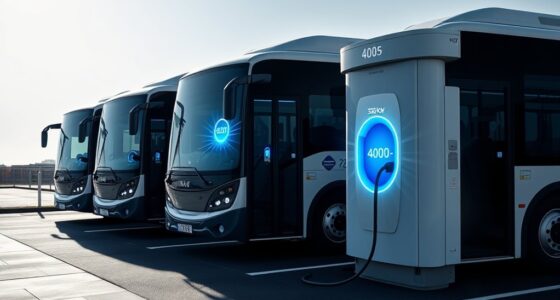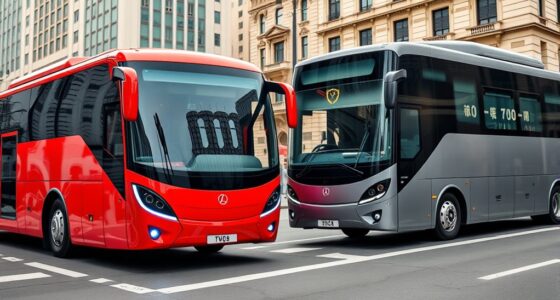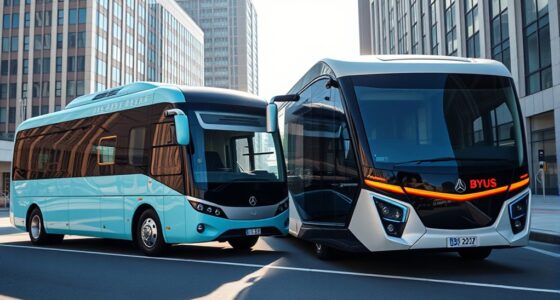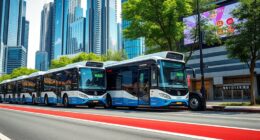Battery electric buses offer lower upfront costs, simpler maintenance, and a typical range of 150-250 miles, making them ideal for shorter routes with charging options nearby. Hydrogen fuel cell buses provide longer ranges of 300-400 miles and quick refueling, but come with higher costs and limited fueling stations. Infrastructure investments vary: charging stations are more common, while hydrogen refueling involves more complex setup. To find out which fits your needs best, explore more details below.
Key Takeaways
- Battery electric buses have a shorter range (150-250 miles) but lower upfront costs and simpler charging infrastructure.
- Hydrogen fuel cell buses offer longer ranges (300-400 miles) but require expensive, specialized refueling stations.
- Electric buses generally have lower maintenance and operational costs due to fewer mechanical parts.
- Hydrogen buses incur higher capital and infrastructure costs but provide quick refueling and longer operational ranges.
- Route length, infrastructure availability, and long-term budget goals are critical factors in choosing between the two technologies.

Have you ever wondered how different clean energy technologies compare for public transportation? When choosing between battery electric buses and hydrogen fuel cell buses, one of the key factors to *look at* is the infrastructure needed to support each technology. Battery electric buses rely heavily on charging infrastructure. You’ll find that charging stations must be strategically placed throughout transit routes to *make sure* buses can recharge quickly and efficiently. Installing these chargers involves significant upfront costs, especially for fast chargers that can replenish batteries in 30 minutes or less. As a result, transit agencies need to plan carefully to avoid service disruptions. Vehicle maintenance also differs between the two technologies. Battery electric buses tend to have lower maintenance needs because they have fewer moving parts—no oil changes, fewer filters, and less complex mechanical systems. This can reduce long-term maintenance costs and downtime, making electric buses attractive from a financial perspective. On the other hand, hydrogen fuel cell buses have their own maintenance requirements, primarily related to fuel cell stacks and hydrogen storage systems. While these components are durable, maintenance can be more specialized and costly, which might offset some of the operational savings gained from longer range capabilities. Additionally, understanding the infrastructure requirements for each technology is crucial for effective planning. Range is another critical factor that influences your decision. Battery electric buses typically offer a shorter range—around 150 to 250 miles per charge—making them suitable for shorter routes or routes with frequent charging opportunities. If your transit system covers extensive routes or operates for long hours, you might find that hydrogen fuel cell buses are more practical. They can often travel 300 to 400 miles on a single tank of hydrogen, reducing the frequency of refueling and allowing for longer continuous operation. However, fueling hydrogen requires access to specialized infrastructure—hydrogen refueling stations—which are still limited compared to electric charging stations. Building this infrastructure involves high costs and technical challenges, but once established, refueling can be quick, typically under 15 minutes, similar to refueling a diesel bus. Cost considerations extend beyond initial purchase prices. While electric buses tend to be cheaper upfront and benefit from lower operating and maintenance costs, hydrogen buses currently have higher capital costs due to the complexity of fuel cell systems and hydrogen storage. You also need to *think about* the infrastructure investment: setting up charging stations versus hydrogen refueling stations. Overall, your choice will depend on your route lengths, budget, and long-term operational goals. Both technologies offer promising clean transportation solutions, but understanding the nuances of infrastructure and maintenance needs is essential to making the best decision for your transit system.
Frequently Asked Questions
How Do Maintenance Costs Compare Between Electric and Hydrogen Buses?
You’ll find that maintenance costs for electric buses are generally lower than hydrogen buses because electric models have fewer moving parts and less complex systems. This results in reduced operational expenses over time. Hydrogen buses require more upkeep due to their fuel cells and high-pressure tanks, increasing maintenance costs. Overall, electric buses tend to be more economical regarding ongoing operational expenses, making them a cost-effective choice for transit agencies.
What Are the Environmental Impacts of Manufacturing Each Bus Type?
Imagine each bus as a seed planted in our planet’s future. Battery electric buses often involve battery recycling, reducing long-term waste, but their manufacturing demands mining for lithium and cobalt, impacting ecosystems. Hydrogen buses, on the other hand, require energy-intensive hydrogen production, sometimes from fossil fuels, which adds pollution. Both have environmental footprints, but choosing wisely can help nurture a greener world for tomorrow.
How Resilient Are These Buses to Extreme Weather Conditions?
You’ll find that both battery electric and hydrogen fuel cell buses face challenges with weather resilience, especially during extreme temperatures. Battery electric buses can experience reduced range and efficiency in very cold or hot weather due to temperature effects on batteries. Hydrogen fuel cell buses tend to handle temperature fluctuations better, but extreme weather can still impact overall performance and infrastructure reliability. Preparing for weather resilience is key to maintaining bus operation.
What Are the Safety Considerations Specific to Hydrogen Fuel Cell Buses?
You should be aware that hydrogen fuel cell buses pose specific safety considerations. Hydrogen leakages can occur if there’s a breach, leading to potential fire hazards. To mitigate these risks, you need proper ventilation systems, leak detection, and strict maintenance protocols. Always guarantee staff are trained on handling hydrogen safely, and regularly inspect storage tanks and fuel cells to prevent accidents related to leaks or fires.
How Quickly Can Each Bus Type Be Refueled or Recharged?
Imagine refueling a bus like filling a water balloon—quick and straightforward. Hydrogen fuel cell buses typically take about 10-15 minutes to refuel, much like a quick pit stop, while battery electric buses require 4-8 hours for a full charge, depending on the charger type. So, refueling time for hydrogen buses is much faster, making them ideal for continuous operation, whereas electric buses need longer charging durations.
Conclusion
When choosing between battery electric and hydrogen fuel cell buses, consider your priorities like range, cost, and infrastructure. Did you know that hydrogen buses can travel over 300 miles on a single tank, outperforming many electric options? This makes hydrogen a compelling choice for longer routes. Ultimately, understanding these differences helps you make a smarter decision for your transit needs, balancing environmental benefits with operational practicality.









